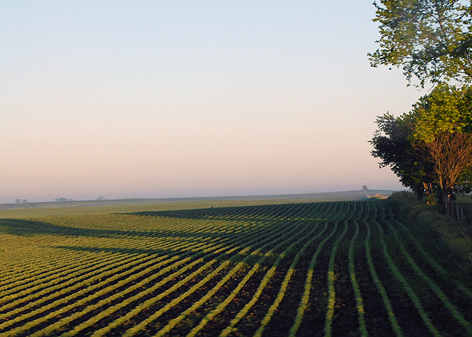
Iowa State University's Gene Takle says Iowa farmers are adjusting in changes to the climate, including higher humidity. Photo by Barb McBreen/College of Agriculture and Life Sciences.
AMES, Iowa – Iowa farmers are already adapting to changes in temperature, precipitation and humidity, Gene Takle of Iowa State University will tell a U.S. Department of Agriculture seminar on climate change.
The seminar is being organized by the USDA’s Climate Change Program Office. It will cover the science of climate change and help USDA staff understand how climate changes are affecting agriculture. The seminar will be June 7 in Washington, D.C., and will be videotaped for later streaming on the USDA’s website. Look under the “Spotlights” section here.
“We appreciate Gene coming out to brief us on his work on the relevance of climate change to agriculture,” said Bill Hohenstein, the director of USDA’s Climate Change Program Office. “Our technical staff is being asked to help farmers manage new risks and vulnerabilities from climate change. Getting access to the latest science and having an opportunity to hear from researchers like Gene is very important in helping us do our job.”
Takle – director of Iowa State's Climate Change Program, a professor of agronomy and of geological and atmospheric sciences – has been studying climate science and regional climate change for about 20 years. He has contributed to the Intergovernmental Panel on Climate Change, the international collaboration that was awarded a share of the 2007 Nobel Peace Prize. He is a coordinating lead author for the agriculture chapter of the U.S. National Climate Assessment now in progress.
His message for the USDA is that Iowa farmers are seeing changes in the growing season (he’ll show chart after chart making the case) and are adapting their crop production practices:
- The growing season is longer and so planting is earlier, with longer-season hybrids and later harvests.
- Springs are wetter and so farmers are using larger machinery to complete harvest in smaller windows of dry weather.
- More summer rain allows planting at higher densities.
- Wetter springs and summers mean more drainage tile is being buried under fields.
- Fewer hot spells mean plants can grow closer together and there are fewer pollination failures.
- Higher humidity means more spraying for pests that prefer moist conditions and longer grain drying in the fall.
- Drier falls mean delaying harvest to take advantage of natural drying in the fields.
The bottom line is the potential for higher yields. “Is it genetics or climate?” Takle asks in his climate change presentations. “Likely some of each.”
Takle believes Midwest farmers have the resources to adapt to climate change – “at least for now.” He also says farmers are adapting to increase profits and prevent losses.
The 2011 Iowa Farm and Rural Life Poll by Iowa State University Extension and Outreach found that 68 percent of Iowa farmers believe climate change is occurring. Of those, 35 percent believe climate change is caused by both natural environmental variations and human activities, about 25 percent attribute climate change to natural changes in the environment, and 10 ten percent believe it is caused mostly by human activities.
Takle said there is good reason to understand climate change: “Based on climate models,” he said, “climate scientists overwhelmingly agree that the future will be more extreme than today.”